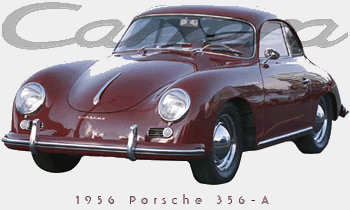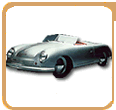|
 356 Porsche 1948
- 1958 356 Porsche 1948
- 1958 |
|
The Porsche Prototype 356/1 (above picture) is the first
Porsche ever produced. The first design drawings were completed
on 17 July 1947 and on 8 June 1948 the Kärnten state government
issued a special permit approving the car. Returning home after
being held by the French as a prisoner of war and bailed out
of custody by his family, Professor Dr.-Ing.h.c. Ferdinand Porsche,
Ferry's father, stated right away that "every single bolt
was just right". Number 1 was then followed by a small
series of 52 additional cars built in Gmünd, production
in Stuttgart from 1950. The intellectual and, indeed, spiritual
"father" of the car was Professor Ferdinand "Ferry"
Porsche, who died on 27 March 1998 at the age of 88.
The Porsche Prototype 356/1 was hand built in early
1948. It has since been restored, and can be seen at the museum
as well as on "tour" across the world.
Rare view - Porsche 356 assembly line
click image
to enlarge
Porsche Vehicle Assembly of the 356 in 1956
A Gmünd Coupe! only 50 built
A Gmünd Coupe! One of about 50 hand built Posches created
while Porsche was still located in Gmünd, Austria.
After the first 356/1 roadster was produced, Porsche made their
2nd car, the 356/2. It was an aluminum coupe. There were 4 of
these made in 1948. Only 25 more were built in 1949, and 18
in 1950. They had rear engines, unlike the 356/1's mid-engine
layout. Perhaps the most distinctive trait is the split windshield.
356 America Roadster (1952)
The Porsche 356 America Roadster (1952)
Simply one of the most coveted Porsches of all time. This beautiful
machine was built in 1952. It was to be only for the American
market and had a lighter, aluminum body built by Gläser.
It had no side windows like the regular Cabrio had. The split
windshield could be removed for racing. Notice its low beltline
and leather hood straps. Between 16 and 20 were produced in
all, and only 11 are still known to exist today.
The 356 type was the first car to bear the name Porsche.
It has become synonymous with "driving at its most glamorous"
and so far the rear-engine sports car in all its numerous manifestations
has lost none of its fascination.
The Porsche synchronous gearbox opened up a new dimension in
driving at its most glamorous. The Porsche of the model year
1953, which actually began in October 1952, not only had better
gear-changing but also braked better as the diameter of the
brake drums had grown from 230 to 280 mm. Visual retouches included
bumpers with rim flanges which were moved even further away
from the bodywork, round tail lights (two on each side) and
flashing indicator lights directly below the headlights.
Finally there was the seal of quality, particularly desired
by foreign customers, a special Porsche coat of arms set into
the horn knob of the new VDM two-spoke steering wheel. The emblem
represented a combination of the arms of the company headquarters
in Stuttgart and Baden-Württemberg and the Porsche logo,
and soon became the symbol of fast, reliable sports cars.
A 1.5 litre engine with roller-borne Hirth crankshaft and a
full 70 HP marked the peak in performance.
Life with a 356 became increasingly luxurious. Modifications
included additional anti-noise material, new seat shapes, Bosch
horns, a pneumatic fuel gauge, an improved windscreen washing
system, a passenger seatbelt and even two clothes hooks.
Cabrio drivers enjoyed a better rear view with tops closed thanks
to an enlarged rear window, while Coupé drivers could
opt to feel the wind in their hair after a mechanical sliding-roof
was added to the accessories list in April. New to the range
was the 60 HP 1300-S engine which had made its debut at the
Paris Salon in October 1953.
In September 1954 Porsche launched a new model which was to
become a legend – the Speedster. The new open-topped Porsche
intended specially for the American market complied with the
motto: "Less is more". The spartan features made the
car not only lighter but also cheaper and the Speedster thus
became the most likely way to enjoy driving made by Porsche.
The racy line with the low windshield was retained even with
the closed emergency cover.
The 55 Porsche range, however, was not only graced with new
bodywork: From November 1954 the engines acquired a three-part
crankcase and driving safety benefited from a front stabilizer
and reinforced steering knuckles.
The Porsche speed speedster was presented in September 1955
and built until August 1958. This basic model 356 cost at that
time DM 11.900,--.The entire production to 356 A speedster amounted
to accurately 2.347 copies.
 |
The Porsche stand at the IAA in Frankfurt in September 1955
was surrounded by curious persons. No wonder since the models
for the coming year launched here had it tough. The 356, now
with the additional letter A, offered better road positioning
than previously thanks to a modified running gear and the engines,
increased from 1.5 to 1.6 litres, improved the running style.
The Coupé and Cabrio now had a curved windshield without
kink and all models including the Speedster acquired a redesigned
dashboard. The sensation in Frankfurt however was the new super
Porsche named the Carrera with an engine that really packed
a punch. For under its bonnet this car had the four-cam shaft
drive gear with vertical shaft drive already launched in 1953
in the racing Spyder. It was designed by Dr. Ernst Fuhrmann
who later described it with a smile as his "youthful sin".
The lavishly built engine produced 100 HP and test driver H.U.
Wieselmann gushed in auto motor und sport: "The sum of
its driving features and its genuinely superb engine give to
those who have the feel for it an experience of pure driving,
the likes of which do not exist."
Porsche driving in the year 1956 was at a high point and on
12th March 1956 the manufacture of the 10,000th Porsche was
celebrated (above photo).
The 356 A, listed internally under the title T 1, changed very
little in this model year. From the early part of the year,
for example, the rear lights were given a teardrop shape and
the front indicators acquired a chrome surround. The rear windows
of the Cabrio and Speedster were enlarged and the cowl-type
emergency cover for the Speedster received a new shape which
allowed more headroom.
TheCarrera dream car was now to be available in GT and de Luxe
variants only. The GT was available later than hoped and therefore
it belongs to model year 1958. The de Luxe was aimed at those
who had previously jokingly described the Carrera as the "most
expensive fridge in Europe". Now an efficient petrol electric
car heater ensured that passengers need no longer freeze. The
GT was aimed at more sporting customers who got ten HP more
power and a lighter car since the side and rear windows in the
GT were made of Plexiglas. Weight was also spared on the bumper
fastenings and the seats, for which Speedster shells were used.
Extra wide drum brakes ensured reliable braking at high speeds.
1958 Porsche 356 Speedster 1600N ivory (below)
Factory Specifications
Engine: 1600 cc air-cooled boxer 4 cyl
Transmission: 4 spd manual
VIN: 84552
Miles: 85,551 mi
1958 Porsche 356a
For this model year Porsche bundled a large package of innovations
which were presented at the IAA in Frankfurt in September 1957.
These included for instance the new and somewhat more directly
operating Ross-type steering which promised greater steering
precision and a new crankcase which improved oil circulation.
The models, internally named T 2, were however recognisable
by the exhaust pipes which penetrated the rear bumper bar; the
Carrera being the exception in this case.
One of the most obvious modifications in the interior was the
new seat form which "arose from the scientific collaboration
of tape coil specialists" as noted by the Stuttgart auto
motor und sport journal. And a contemporary brochure showing
a delicate female hand reaching for the gear stick is evidence
that Porsche driving was not intended as just a boy's thing.
"Power and elegance at your fingertips" was the caption
– certainly not just a reference to the more easily reached
gear stick of the T 2 but also to the new diaphragm spring clutch
which required far less effort than the earlier version.
The range also included a new hardtop available for the Cabrio
and the Speedster.
|




